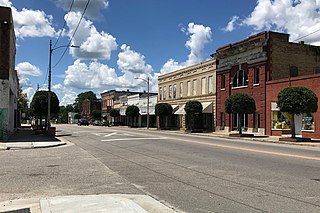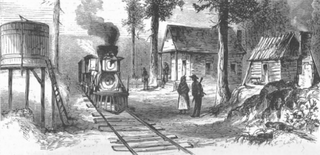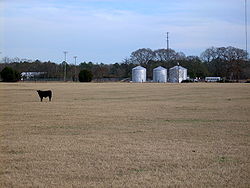
Chapel Hill is a town in Orange and Durham County, North Carolina, United States. Its population was 61,960 in the 2020 census, making Chapel Hill the 17th-most populous municipality in the state. Chapel Hill and Durham make up the Durham-Chapel Hill, NC Metropolitan Statistical Area, which had an estimated population of 608,879 in 2023. When it's combined with Raleigh, the state capital, they make up the corners of the Research Triangle, which had an estimated population of 2,368,947 in 2023.

Scotland County is a county located in the southern part of the U.S. state of North Carolina. Its county seat is and largest community is Laurinburg. The county was formed in 1899 from part of Richmond County and named in honor of the Scottish settlers who occupied the area in the 1700s. As of the 2020 census, its population was 34,174.

Robeson County is a county in the southern part of the U.S. state of North Carolina and is its largest county by land area. Its county seat and largest community is Lumberton. The county was formed in 1787 from part of Bladen County and named in honor of Thomas Robeson, a colonel who had led Patriot forces in the area during the Revolutionary War. As of the 2020 census, the county's population was 116,530. It is a majority-minority county; its residents are approximately 38 percent Native American, 22 percent white, 22 percent black, and 10 percent Hispanic. It is included in the Fayetteville-Lumberton-Pinehurst, NC Combined Statistical Area. The state-recognized Lumbee Tribe of North Carolina is headquartered in Pembroke.

Hoke County is a county in the U.S. state of North Carolina. As of the 2020 census, its population was 52,082. Its county seat is Raeford.

Cumberland County is a county located in the U.S. state of North Carolina. As of the 2020 census, the population was 334,728, making it the fifth-most populous county in North Carolina. Its county seat is Fayetteville. Cumberland County is part of the Fayetteville, NC Metropolitan Statistical Area.

Bladen County is a county located in the U.S. state of North Carolina. As of the 2020 census, the population was 29,606. Its county seat is Elizabethtown. The county was created in 1734 as Bladen Precinct and gained county status in 1739.

Bladenboro is a town in Bladen County, North Carolina, United States. At the 2020 census, the population was 1,648.

Concord is the county seat and most populous city in Cabarrus County, in the U.S. state of North Carolina. At the 2020 census, the city had a population of 105,240. In terms of population, the city of Concord is the second-most populous city in the Charlotte metropolitan area and is the 10th-most populous city in North Carolina and 287th-most populous city in the U.S.

Centerville is a census-designated place (CDP) in the rural northeastern corner of Franklin County, North Carolina, United States. The population was 149 at the 2020 census. It was an incorporated town from 1965 to 2017.

Franklinton is a town in Franklin County, North Carolina, United States. The population was 2,456 at the 2020 census.

Lincolnton is a city in Lincoln County, North Carolina, United States within the Charlotte metropolitan area. The population was 10,486 at the 2010 census. Lincolnton is northwest of Charlotte, on the South Fork of the Catawba River. The city is the county seat of Lincoln County.

Jacksonville is a city in Onslow County, North Carolina. As of the 2020 census, the population was 72,723, which makes Jacksonville the 14th-most populous city in North Carolina. Jacksonville is the county seat and most populous community of Onslow County, which is coterminous with the Jacksonville, NC Metropolitan Statistical Area. Demographically, Jacksonville is the youngest city in the United States, with an average age of 22.8 years old, which can be attributed to the large military presence. The low age may also be in part due to the population drastically increasing over the past 80 years, from 783 in the 1930 census to 72,723 in the 2020 census.

Fairmont is a town in Robeson County, North Carolina, United States. The population was 2,191 at the 2020 census.

Raynham is a town in Robeson County, North Carolina, United States. The population was 60 at the 2020 census.

Rowland is a town in Rowland Township, Robeson County, North Carolina, United States. The population was 885 at the 2020 census.
Oak Grove is an unincorporated community in northern Surry County, North Carolina, United States, located near Bottom.

Bahama is an unincorporated community in northern Durham County, North Carolina, United States.

The following outline is provided as an overview of and topical guide to the U.S. state of North Carolina. Wikipedia:WikiProject North Carolina Category:Top-importance North Carolina articles are indicated.
Purdie House and Purdie Methodist Church is a historic home and Methodist church located near Tar Heel, Bladen County, North Carolina. The house was built about 1803–1806, and is a two-story, four bay by two bay, brick Federal-style dwelling. It has a steep gable roof and two-story gallery porches. Purdie Methodist Church is a mid-19th century temple-form Greek Revival-style frame building.

Moss Neck is a community in Robeson County, North Carolina, United States.




















